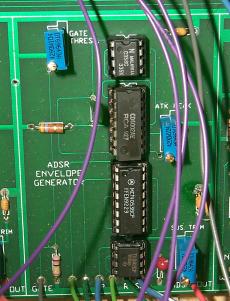 The
ADSR (Attack-Decay-Sustain-Release) module is used to control the
VCF and VCA modules and thereby determine the dynamic harmonic structure
and dynamic amplitude characteristic of the VCO signals.
The
ADSR (Attack-Decay-Sustain-Release) module is used to control the
VCF and VCA modules and thereby determine the dynamic harmonic structure
and dynamic amplitude characteristic of the VCO signals.
It is often not realised, even by musicians, how much the character of an instrument is determined by the dynamic amplitude and harmonic behaviour, rather than by the steady-state harmonic content of an instrument. If the attack and decay periods of a note are artificially modified, then the whole character of the sound is altered. For example, starting with a triangle output from the VCO, a whole range of instrument sounds can be produced simply by varying the amplitude envelope, ranging from `soft' sounds such as flute and some organ voices, to `hard' percussive sounds such as piano and xylophone.
Envelope control of the harmonic content using the VCF allows even greater variation in the character of the sound.
The ADSR module will generate Attack-Decay-Sustain-Release control signals upon receipt of a positive GATE signal. Irrespective of the length of the GATE signal the ADSR will always generate an Attack-Release curve. Decay and Sustain portions of the curve are dependent upon the presence of the GATE signal for a minimum time as follows:-
ADR curves -> GateOn = Attack + Decay + Release
ADSR curves -> GateOn > Attack + Decay + Release. The Sustain time will be equal to the difference between the GateOn time and the total of Attack + Decay + Release times.
The ADSR module has the following features:-
Specification:
- Attack time - 1ms to 15s
- Decay time - 1ms to 15s
- Release time - 1ms to 15s
- Sustain level - 0V to +5V
Connectors:
- Gate In (adjustable from 0V to +15V)
- Envelope Out (maximum is adjustable from 0V to +15V
Available in FracRack format from MetalBox

